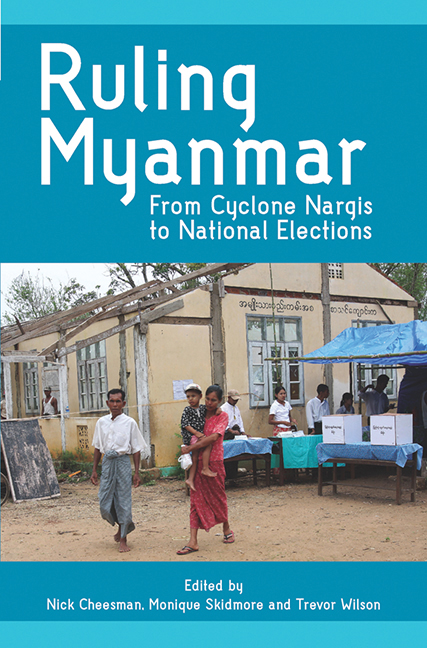Book contents
- Frontmatter
- Contents
- List of Tables
- List of Figures
- Background on ANU 2009 Myanmar/Burma Update Conference
- Acknowledgements
- Contributors and Editors
- Note on Terminology and Geographical Names
- Map of Myanmar
- Part I Overview
- Part II Political Legitimacy, Governance and Justice
- 2 2010 and the Unfinished Task of Nation-building
- 3 Burma's Political Transition: Implications for U.S. Policy
- 4 Sovereignty in the Shan State: A Case Study of the United Wa State Army
- 5 Governance and Legitimacy in Karen State
- 6 The Incongruous Return of Habeas Corpus to Myanmar
- Part III Economic Development, the Rural Economy and Labour Rights
- Part IV The Role of International Cooperation and Governance
- List of Abbreviations
- Index
5 - Governance and Legitimacy in Karen State
from Part II - Political Legitimacy, Governance and Justice
Published online by Cambridge University Press: 21 October 2015
- Frontmatter
- Contents
- List of Tables
- List of Figures
- Background on ANU 2009 Myanmar/Burma Update Conference
- Acknowledgements
- Contributors and Editors
- Note on Terminology and Geographical Names
- Map of Myanmar
- Part I Overview
- Part II Political Legitimacy, Governance and Justice
- 2 2010 and the Unfinished Task of Nation-building
- 3 Burma's Political Transition: Implications for U.S. Policy
- 4 Sovereignty in the Shan State: A Case Study of the United Wa State Army
- 5 Governance and Legitimacy in Karen State
- 6 The Incongruous Return of Habeas Corpus to Myanmar
- Part III Economic Development, the Rural Economy and Labour Rights
- Part IV The Role of International Cooperation and Governance
- List of Abbreviations
- Index
Summary
INTRODUCTION
Karen-populated areas of Burma/Myanmar have been affected by armed conflict since 1949, the year after independence. For much of this period, the Karen National Union (KNU) operated as a de facto government, controlling large swathes of territory across Karen State, and adjacent areas of Mon State, and Pegu and Tenasserim Divisions. Although not recognized internationally, the KNU administration aspired to reproduce in areas under its control the (Weberian) “modern/rational-bureaucratic” state, fielding departments for health, education, and civil administration, and making claims to a legitimate monopolization of violence, and rights to extract taxes from the population.
By the 1990s the KNU had lost control of most of its once-extensive “liberated zones” — although the organization still exerted varying degrees of influence over areas contested with government forces and proxy militias. This process was accompanied by a dramatic fall in revenues which the organization derived from taxing the black-market cross-border trade, and from logging deals. The decline of the KNU was exacerbated by the defection in late 1994 of several hundred battle-hardened soldiers, who established the government-allied Democratic Karen Buddhist Army (DKBA), in protest against the Christian domination of the KNU, and the failure of its long-term leader, the charismatic General Bo Mya (who died in 2006), to discipline adequately field commanders operating under his authority.
Ten years later, the DKBA had displaced the KNU's armed wing — the Karen National Liberation Army (KNLA) — as the militarily and economically most powerful Karen non-state actor in Burma. Other ex- KNU/KNLA armed factions included the Karen Peace Force (KPF, established 1997) in southern Karen State, the “P'doh Aung San Group” (1998) and KNU-KNLA Peace Council (PC, 2007) in central Karen State, and two small ceasefire groups in northern Karen State (which split from the KNU in 1997), as well as various local militias. Whereas in previous years the KNU had been strong enough to demand at least symbolic loyalty from locally based field commanders — many of whom operated under the umbrella of the Karen national movement — the collapse of the organization's fortunes in the 1990s led to the splintering of the old insurgent paradigm, and the reorientation of specialists in violence towards the military government and its networks of control.
Information
- Type
- Chapter
- Information
- Ruling MyanmarFrom Cyclone Nargis to National Elections, pp. 63 - 89Publisher: ISEAS–Yusof Ishak InstitutePrint publication year: 2010
